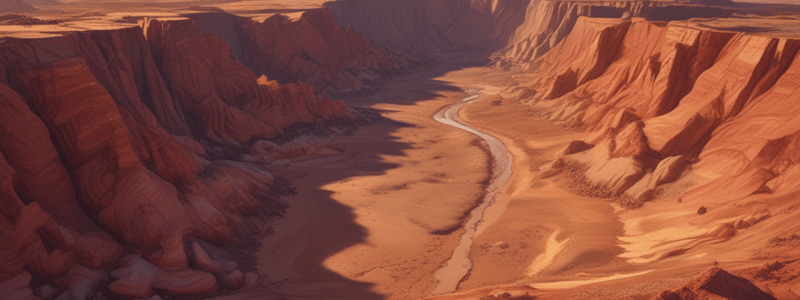Podcast
Questions and Answers
What is the primary characteristic of colloidal clay particles, despite being the smallest type of clay particles?
What is the primary characteristic of colloidal clay particles, despite being the smallest type of clay particles?
They have the greatest capacity for ion exchange.
What type of water is available for plant uptake, and where is it typically held in the soil?
What type of water is available for plant uptake, and where is it typically held in the soil?
Capillary water, held in large pores between the soil aggregates.
What is the ratio of pore space to soil volume in a typical soil?
What is the ratio of pore space to soil volume in a typical soil?
50% pore space (air and water) and 50% soil volume.
What type of soil has intermediate characteristics of clay and sandy soils, and what is its composition?
What type of soil has intermediate characteristics of clay and sandy soils, and what is its composition?
Signup and view all the answers
What is the product of the breakdown of organic matter, and what are its characteristics?
What is the product of the breakdown of organic matter, and what are its characteristics?
Signup and view all the answers
What is the primary difference between gravitational water and capillary water in soil?
What is the primary difference between gravitational water and capillary water in soil?
Signup and view all the answers
What are the primary characteristics of clay soils, and how do they affect plant growth?
What are the primary characteristics of clay soils, and how do they affect plant growth?
Signup and view all the answers
What is the primary advantage of loam soil over sandy and clay soils?
What is the primary advantage of loam soil over sandy and clay soils?
Signup and view all the answers
What is the significance of soil texture in determining soil properties?
What is the significance of soil texture in determining soil properties?
Signup and view all the answers
Describe the importance of good soil structure for healthy plant growth.
Describe the importance of good soil structure for healthy plant growth.
Signup and view all the answers
Explain the effects of soil compaction on soil structure and plant growth.
Explain the effects of soil compaction on soil structure and plant growth.
Signup and view all the answers
How does organic matter loss affect soil structure and fertility?
How does organic matter loss affect soil structure and fertility?
Signup and view all the answers
Describe the types of water held in soil and their availability to plants.
Describe the types of water held in soil and their availability to plants.
Signup and view all the answers
Explain the significance of soil colour in determining soil fertility.
Explain the significance of soil colour in determining soil fertility.
Signup and view all the answers
Describe the impact of soil temperature on plant growth and development.
Describe the impact of soil temperature on plant growth and development.
Signup and view all the answers
How does erosion, sedimentation, and weathering affect soil structure and fertility?
How does erosion, sedimentation, and weathering affect soil structure and fertility?
Signup and view all the answers
Study Notes
Physical Properties of Soil
- Soil texture is a measure of the proportion of different sized particles (sand, silt, clay) in a soil sample.
- Soil structure is the arrangement of soil particles in a soil.
Particle Size and Soil Types
- Mineral matter is derived from parent rock and classified by size.
- Soil types:
- Sandy soils: large air pores, free draining, easy to work with, but dry out quickly and have low nutrient levels.
- Clay soils: hold water easily, fertile, but have poor drainage, leading to waterlogging.
- Loam soil: contains equal amounts of sand, silt, and clay, with intermediate characteristics of clay and sandy soils.
Organic Matter
- Humus is the product of the breakdown of organic matter (humification).
- Dark sticky material that absorbs water, improves soil quality, and is rich in nutrients.
Soil Texture and Drainage
- Soil texture is a fixed property of soil that cannot be changed.
- The ratio of sand, silt, and clay determines soil texture, affecting drainage, aeration, and fertility.
Determining Soil Texture
- Hand testing, sedimentation, and soil sieve are methods to determine soil texture.
Soil Structure
- Floccules contain micropores, while pores between adjacent floccules are macropores.
- Good soil structure is necessary for:
- Healthy plant growth: provides aeration, water drainage, and root penetration.
- Nutrient availability.
- Microbial activity.
Impact of Various Factors on Soil Structure
- Factor 1 - Soil Compaction: destroys soil structure, reduces pore space, and affects plant growth.
- Factor 2 - Organic Matter Loss: poorer structure, lower nutrient availability, and lower water retention.
- Factor 3 - Erosion, Sedimentation, and Weathering: loss of organic matter, soil particles, and nutrient-rich topsoil.
Soil Water
- Water is held in soil due to attraction to negative charges of clay particles.
- Types of water in soil: hygroscopic water, capillary water, and gravitational water.
Soil Colour
- Dark brown, black colour indicates rich humus, high fertility, and nutrient-rich soils.
- Light colour or grey soils tend to have low fertility, low nutrient levels, and suffer from leaching.
Soil Temperature
- Lower temperature results in lower germination and water and mineral uptake.
- Soil temperature affects plant growth and development.
Studying That Suits You
Use AI to generate personalized quizzes and flashcards to suit your learning preferences.
Description
This booklet covers soil texture, structure, colloidal clay, and capillary water. Understand the physical properties of soil samples and their components.




